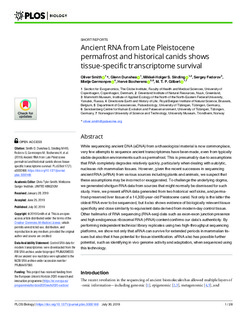| dc.contributor.author | Smith, Oliver | |
| dc.contributor.author | Dunshea, Glenn | |
| dc.contributor.author | Sinding, Mikkel-Holger | |
| dc.contributor.author | Fedorov, Sergey | |
| dc.contributor.author | Germonpre, Mietje | |
| dc.contributor.author | Bocherens, Hervé | |
| dc.contributor.author | Gilbert, Marcus Thomas Pius | |
| dc.date.accessioned | 2020-01-03T07:47:43Z | |
| dc.date.available | 2020-01-03T07:47:43Z | |
| dc.date.created | 2019-09-05T12:28:28Z | |
| dc.date.issued | 2019 | |
| dc.identifier.citation | PLoS Biology. 2019, 17 (7), 1-28. | nb_NO |
| dc.identifier.issn | 1544-9173 | |
| dc.identifier.uri | http://hdl.handle.net/11250/2634688 | |
| dc.description.abstract | While sequencing ancient DNA (aDNA) from archaeological material is now commonplace, very few attempts to sequence ancient transcriptomes have been made, even from typically stable deposition environments such as permafrost. This is presumably due to assumptions that RNA completely degrades relatively quickly, particularly when dealing with autolytic, nuclease-rich mammalian tissues. However, given the recent successes in sequencing ancient RNA (aRNA) from various sources including plants and animals, we suspect that these assumptions may be incorrect or exaggerated. To challenge the underlying dogma, we generated shotgun RNA data from sources that might normally be dismissed for such study. Here, we present aRNA data generated from two historical wolf skins, and permafrost-preserved liver tissue of a 14,300-year-old Pleistocene canid. Not only is the latter the oldest RNA ever to be sequenced, but it also shows evidence of biologically relevant tissue specificity and close similarity to equivalent data derived from modern-day control tissue. Other hallmarks of RNA sequencing (RNA-seq) data such as exon-exon junction presence and high endogenous ribosomal RNA (rRNA) content confirms our data’s authenticity. By performing independent technical library replicates using two high-throughput sequencing platforms, we show not only that aRNA can survive for extended periods in mammalian tissues but also that it has potential for tissue identification. aRNA also has possible further potential, such as identifying in vivo genome activity and adaptation, when sequenced using this technology. | nb_NO |
| dc.language.iso | eng | nb_NO |
| dc.publisher | PLOS, Public Library of Science | nb_NO |
| dc.rights | Navngivelse 4.0 Internasjonal | * |
| dc.rights.uri | http://creativecommons.org/licenses/by/4.0/deed.no | * |
| dc.title | Ancient RNA from Late Pleistocene permafrost and historical canids shows tissue-specific transcriptome survival | nb_NO |
| dc.type | Journal article | nb_NO |
| dc.type | Peer reviewed | nb_NO |
| dc.description.version | publishedVersion | nb_NO |
| dc.source.pagenumber | 1-28 | nb_NO |
| dc.source.volume | 17 | nb_NO |
| dc.source.journal | PLoS Biology | nb_NO |
| dc.source.issue | 7 | nb_NO |
| dc.identifier.doi | 10.1371/journal.pbio.3000166 | |
| dc.identifier.cristin | 1721881 | |
| dc.description.localcode | Copyright: © 2019 Smith et al. This is an open access article distributed under the terms of the Creative Commons Attribution License, which permits unrestricted use, distribution, and reproduction in any medium, provided the original author and source are credited. | nb_NO |
| cristin.unitcode | 194,31,10,0 | |
| cristin.unitname | Institutt for naturhistorie | |
| cristin.ispublished | true | |
| cristin.fulltext | original | |
| cristin.qualitycode | 2 | |

